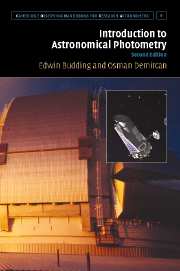Book contents
- Frontmatter
- Contents
- Preface to first edition
- Preface to second edition
- 1 Overview
- 2 Introduction
- 3 Underlying essentials
- 4 Themes of astronomical photometry
- 5 Practicalities
- 6 Procedures
- 7 Basic light curve analysis
- 8 Period changes in variable stars
- 9 Close binary systems
- 10 Spotted stars
- 11 Pulsating stars
- Appendix
- Author index
- Subject index
5 - Practicalities
Published online by Cambridge University Press: 13 August 2009
- Frontmatter
- Contents
- Preface to first edition
- Preface to second edition
- 1 Overview
- 2 Introduction
- 3 Underlying essentials
- 4 Themes of astronomical photometry
- 5 Practicalities
- 6 Procedures
- 7 Basic light curve analysis
- 8 Period changes in variable stars
- 9 Close binary systems
- 10 Spotted stars
- 11 Pulsating stars
- Appendix
- Author index
- Subject index
Summary
Overview of basic instrumentation
Figure 5.1 schematizes the essential optical photometric system in its observatory setting. At the heart of the system is the detector. The excitation of electrons responding to incident photons, whose acquired energy then allows them to be registered in some way, forms the basis for practical flux measurement in more or less all photometric systems. With this there has been a continued trend towards more reliably linear, efficient and informative detectors. The photocathode (photomultiplier) tube, a single channel, spatially non-resolving device, has been the simplest type of linear detector in general use. However, the advent of efficient areal detectors, bulk data-handling facilities and software improvements that can efficiently control observing instruments, as well as process raw data into manageable form, have revolutionized ground-based astronomical photometry in the last decade or so. This was already evident from the widening new horizons of the previous chapter's review, and will be reinforced as we progress. But our more immediate purpose is to draw out the practical groundwork on which useful data relies. Overviewing this allows us to see how common elements in photon flux measurement have developed, sometimes along new and separate paths, but with generally parallel aims, often involving the same or similar principles.
Referring to the scheme of Figure 5.1, the optical arrangements in front (foreoptics) are designed to direct suitably selected fluxes from astronomical sources to the detector element. After electrons have been photo-energized, their activity is to be registered by appropriate electronics.
Information
- Type
- Chapter
- Information
- Introduction to Astronomical Photometry , pp. 161 - 203Publisher: Cambridge University PressPrint publication year: 2007
